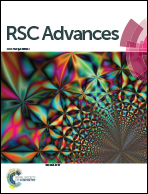The effect on ion channel of different protonation states of E90 in channelrhodopsin-2: a molecular dynamics simulation†
Abstract
Channelrhodopsin-2 (ChR2) is a cationic channel protein that has been extensively studied in optogenetics. The ion channel is opened via a series of proton transfers and H-bond changes during the photocycle but the detailed mechanism is still unknown. Molecular dynamics (MD) simulations with enhanced sampling were performed on the dark-adapted state (i.e., D470) and two photocycle intermediates (P1500 and P2390) to study the proton transfer path of the Schiff base and the subsequent conformational changes. The results suggest there are two possible proton transfer pathways from the Schiff base to proton acceptors (i.e., E123 or D253), depending on the protonation of E90. If E90 is protonated in the P1500 state, the proton on the Schiff base will transfer to E123. The polyene chain of 13-cis retinal tilts and opens the channel that detours the blocking central gate (CG) and forms a narrow channel through the transmembrane helices (TM) 2, 3, 6 and 7. In contrast, if E90 deprotonates after retinal isomerization, the primary proton acceptor is D253, and an almost-open channel through TM1, 2, 3 and 7 is generated. The channel diameter is very close to the experimental value. The potential mean force (PMF) suggests that the free energy is extremely low for ions passing through this channel.



 Please wait while we load your content...
Please wait while we load your content...